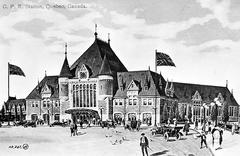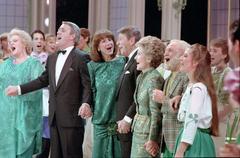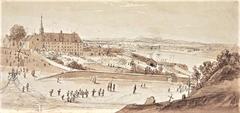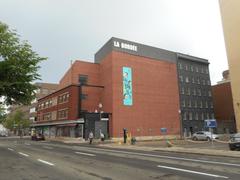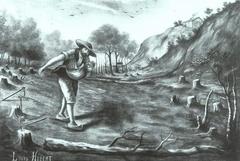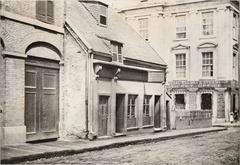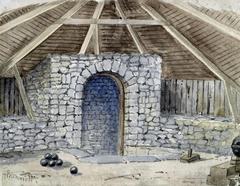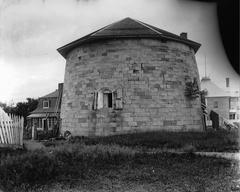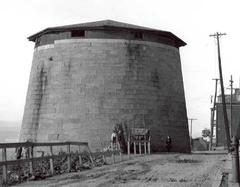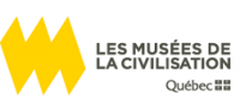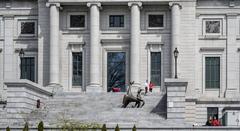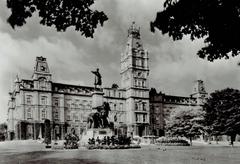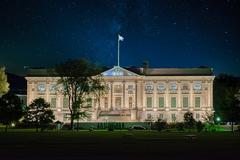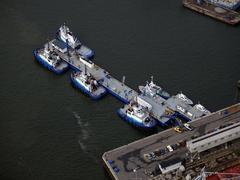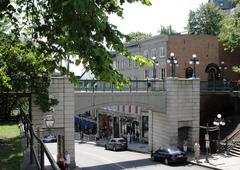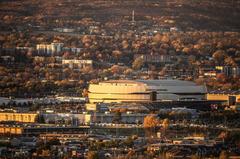
Boulevard René-Lévesque Quebec City: Visiting Hours, Tickets, and Historical Sites Guide
Date: 04/07/2025
Introduction
Boulevard René-Lévesque is one of Quebec City’s most dynamic and historically important thoroughfares, seamlessly blending the city’s rich past with its modern urban identity. Once known as Boulevard Saint-Cyrille, this boulevard has evolved from a modest connector road in the late 19th century to a vital axis of government, culture, and commerce. Today, it stands as a symbol of Quebec’s evolving identity, named in 1992 for Premier René Lévesque—a figure who remains central to the province’s political, cultural, and linguistic heritage. Along its length, visitors encounter striking architectural landmarks, vibrant cultural venues, and a bustling civic life that reflects both the city’s traditions and its ambitions for the future.
This detailed guide explores the boulevard’s historical development, architectural highlights, practical visitor information (including hours and ticketing), accessibility, transportation, and the best nearby attractions. It is designed for travelers, history enthusiasts, and anyone eager to experience the essence of Quebec City.
(Wikipedia, Ville de Québec, Commission de toponymie du Québec)
Table of Contents
- Origins and Early Development
- Modernization and Urban Renewal
- Honoring René Lévesque
- Urban Role and Significance
- Architectural and Cultural Landmarks
- Visitor Information
- Social and Urban Legacy
- Notable Historical Events and Transformations
- Frequently Asked Questions (FAQ)
- Conclusion
- Sources and Further Reading
Origins and Early Development
Boulevard René-Lévesque originated as Boulevard Saint-Cyrille in the late 19th century, built to connect expanding neighborhoods outside Old Quebec’s fortified walls. Its early years saw gradual extensions, integrating portions of older roads like the chemin Gomin, reflecting the city’s growth and increasing demand for modern transportation corridors. By the mid-20th century, it had become a major east-west thoroughfare, paralleling the St. Lawrence River and uniting Quebec City’s central and western districts. (Wikipedia)
Modernization and Urban Renewal (1960s–1970s)
A period of rapid modernization reshaped Quebec City—and especially Boulevard René-Lévesque—in the 1960s and 1970s. Driven by ambitious urban planning, the city undertook large-scale redevelopment in the Saint-Jean-Baptiste neighborhood and downtown core. More than 2,000 buildings—many of them Victorian-era homes—were demolished to make way for new roads, office towers, hotels, and commercial complexes, including Place-Québec and the Dufferin-Montmorency expressway. Notable skyscrapers such as Complexe G, Édifice de la Haute-Ville, 800 d’Youville, Hilton Quebec, and Hôtel Le Concorde rose along the boulevard, transforming the city’s skyline and establishing a modern administrative and business center.
While these changes propelled Quebec City into modernity, they also sparked controversy due to the loss of heritage buildings and disruption of established communities, prompting later reevaluation of urban planning priorities. (Ville de Québec)
Honoring René Lévesque
In 1992, the boulevard was renamed to honor René Lévesque, Quebec’s 23rd Premier (1976–1985) and a defining figure in the province’s political evolution. Lévesque’s legacy includes the Charter of the French Language (Bill 101), the first referendum on Quebec sovereignty, and numerous social reforms. The renaming coincided with broader efforts to commemorate his impact; a prominent statue of Lévesque was later installed outside the Parliament Building, and in 2012, he was officially designated a historical figure. These commemorations have turned the boulevard into a living tribute to his enduring influence. (Commission de toponymie du Québec, Kids Kiddle)
Urban Role and Significance
Today, Boulevard René-Lévesque is a critical urban corridor running from the Cité-Universitaire (near Université Laval) in the west, through residential and commercial districts, and culminating at Parliament Hill in the city center. It is a major route for public transit (particularly the Métrobus system), a stage for parades and demonstrations, and a connector for key institutions like the National Assembly, Grand Théâtre de Québec, and Centre des congrès de Québec. Its central location and accessibility make it essential for both residents and visitors. (Commission de toponymie du Québec)
Architectural and Cultural Landmarks
Boulevard René-Lévesque is lined with a diverse array of landmarks, each reflecting a chapter in Quebec City’s history:
- Édifice Honoré-Mercier: Office of the Premier of Quebec.
- Grand Théâtre de Québec: Renowned performing arts venue with striking brutalist architecture.
- Centre des congrès de Québec (Quebec City Convention Centre): Major convention and event space.
- Place-Québec: Commercial and business complex.
- Monument to René Lévesque: Iconic statue and gathering spot.
- Édifice Marie-Guyart (Complexe G): The city’s tallest building, featuring the Observatoire de la Capitale.
- Saint-Dominique Church: Neo-Gothic religious landmark with impressive stained-glass windows.
- Parc de l’Amérique-Française and Place George-V: Green spaces and ceremonial squares frequented during public events and festivals.
(Kids Kiddle, Quebec City Convention Centre, Grand Théâtre de Québec, Observatoire de la Capitale)
Visitor Information
Visiting Hours
- Boulevard René-Lévesque: Open 24/7 as a public street.
- Grand Théâtre de Québec: Box office open Tuesday–Saturday, 12:00 PM–6:00 PM (check for showtimes).
- Convention Centre: Monday–Friday, 8:00 AM–6:00 PM; weekends depend on scheduled events.
- Observatoire de la Capitale: Daily, 10:00 AM–5:00 PM.
- Parliament Building: Monday–Friday, 9:00 AM–5:00 PM, with guided tours 10:00 AM–4:00 PM.
Tickets and Entry Fees
- Public Street and Monuments: Free access.
- Cultural Venues: Tickets required for performances (Grand Théâtre), exhibitions, or observation deck access (Observatoire de la Capitale).
- Guided Tours: Advance booking recommended for walking, biking, or bus tours.
(Grand Théâtre de Québec tickets and visiting info, Observatoire de la Capitale, Parliament Building Quebec tickets and tours)
Accessibility & Transportation
- Public Transit: Served by multiple RTC bus lines; frequent service along the boulevard.
- Walking and Cycling: Wide sidewalks, bike lanes, and crosswalks with audible signals; wheelchair-accessible.
- Parking: Public lots and street parking available; garages recommended during busy events.
Nearby Attractions & Guided Tours
- Old Quebec (Vieux-Québec): UNESCO World Heritage Site, accessible within minutes on foot.
- Plains of Abraham: Expansive historic park north of the boulevard.
- Musée de la civilisation: Top museum for Quebec’s culture and history.
- Rue Cartier & Avenue Honoré-Mercier: Shopping, dining, and entertainment districts nearby.
Guided tours often include the boulevard as part of wider explorations of Quebec City’s political, historical, and cultural heritage. (Québec City Walking Tours)
Photographic Spots
- Parliament Building and its gardens
- Monument to René Lévesque
- Observatoire de la Capitale for panoramic views
- Grand Théâtre’s exterior mural
- Seasonal decorations along Rue Cartier
Social and Urban Legacy
The transformation of Boulevard René-Lévesque in the 1960s and 1970s underscored the tension between modernization and heritage preservation. While the new infrastructure established Quebec City as a contemporary capital, it came at the cost of razed neighborhoods and lost historic architecture. In response, later urban planning initiatives have focused on promoting inclusivity, accessibility, and the preservation of remaining heritage sites—ensuring the boulevard remains a space for both modern civic life and the celebration of Quebec’s traditions. (Ville de Québec)
Notable Historical Events and Transformations
- 1960s–1970s Urban Renewal: Major demolition and construction reshaped the urban landscape.
- 1992: Boulevard renamed to honor Premier René Lévesque.
- 2012: Lévesque officially recognized as a historical figure; monument inaugurated.
- Ongoing: The boulevard remains a hub for parades, demonstrations, and cultural events, reflecting its enduring civic significance.
Frequently Asked Questions (FAQ)
Q: Is Boulevard René-Lévesque open to the public at all times?
A: Yes, the boulevard is a main city street accessible 24/7. Certain venues have their own operating hours.
Q: Are tickets required for any attractions?
A: The boulevard and outdoor monuments are free. Tickets are needed for performances, museum exhibitions, and some tours.
Q: How do I get to Boulevard René-Lévesque?
A: It is well-served by public buses, taxis, and is walkable from train and bus stations. Parking is also available.
Q: Is the area accessible for people with disabilities?
A: Yes, sidewalks, crosswalks, and major buildings comply with accessibility standards.
Q: Are guided tours available?
A: Yes, several companies and tourism offices offer walking, biking, and bus tours along or including the boulevard.
Conclusion
Boulevard René-Lévesque exemplifies Quebec City’s historical depth, cultural richness, and ongoing evolution. From political milestones and architectural icons to vibrant festivals and green spaces, it offers a comprehensive glimpse into the city’s spirit. For the best experience, plan ahead by consulting official resources for up-to-date hours, events, and ticketing. Enhance your visit with guided tours and digital tools like the Audiala app, and take time to enjoy the boulevard’s many photographic spots and local culture.
Explore more about Quebec City’s historical sites and plan your perfect trip today!
Tip: Enhance your visit with high-quality images and interactive maps of Boulevard René-Lévesque and its landmarks. Alt tags should include phrases like “Boulevard René-Lévesque Quebec City,” “René Lévesque statue,” and “Quebec City historical sites.”
Sources and Further Reading
- Boulevard René-Lévesque: A Visitor’s Guide to Quebec City’s Historic and Cultural Landmark, Ville de Québec
- Boulevard René-Lévesque (Québec) - Wikipedia
- Commission de toponymie du Québec - Boulevard René-Lévesque
- René Lévesque - Kids Kiddle Encyclopedia
- Québec City Must-See Attractions
- Musée de la civilisation - René and Lévesque: An Intimate Portrait
- Quebec City Convention Centre
- Grand Théâtre de Québec
- Observatoire de la Capitale
- Saint-Dominique Church
- Parc de l’Amérique-Française info
- Manège militaire Voltigeurs de Québec info
- Hôtel Château Laurier Québec
- Auberge aux Deux Lions
- Rue Cartier info
- Place d’Youville info
- Old Quebec visiting info
- Plains of Abraham info
- Quebec Winter Carnival details







